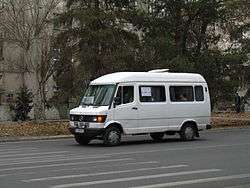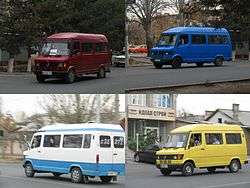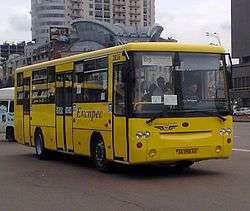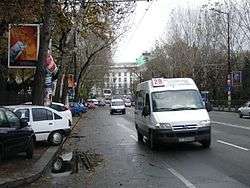Marshrutka

Marshrutka (Russian: маршру́тка [mɐrˈʂrutkə]), from marshrutn[oy]e taksi routed taxicab, is a form of public transportation such as a share taxi for the countries of CIS, the Baltic states, Bulgaria and Georgia. The role of the modern marshrutka is theoretically similar to the share taxi, that use minibuses in other countries.
Etymology
The Russian word "маршрутка" is the colloquial form for "маршрутное такси", which literally means "routed taxi(cab)" ("маршрут" referring to a planned route that something follows, and "такси" meaning "taxi(cab)"). The word "маршрут" is from the German word "Marschroute", which is composed of the word "Marsch" (a walk, march) and "Route" (route).
History
Early days (pre-1992)
"Route taxicabs" were introduced in Moscow for the first time in the USSR in 1938, operated by ZiS-101 limousines.[1] They offered ordinary people their only chance to ride in luxurious ZiS cars, otherwise reserved for high officials. At first they were meant mainly for tourists and serviced mainly stations and airports. Unlike ordinary taxicabs using taximeters, routed taxicab rides charged by zones, like trams, buses and trolley buses; the fares ranked cheaper than those of ordinary taxis, but higher than in large-scale public transport. Unlike ordinary taxis, where a passenger could enjoy a private ride, the routed taxicab would also pick up and drop passengers along its route. During communist rule, state-owned taxicab parks operated all marshrutkas.[1]
Other large Soviet cities apart from Moscow also organized routed taxis. For example, Gorky had a routed taxi line between Sormovo and the Nizhny Novgorod Kremlin. As of 1939, the full fare was 3½ roubles; a similar service cost 1 rouble with a bus, or 50 kopecks with a tram.[1][2]
During the Great Patriotic War of 1941-1945, as the Red Army requisitioned cars, routed taxi services ceased. They resumed in Moscow in 1945.[1] Only by the 1950s did they re-appear in most cities where they had operated before the war. The ZiS-110 and GAZ-12 ZIM cars served widely in this role until the mid-1960s.
Routed taxicabs also offered interurban services. From Moscow they drove to distant cities, like Simferopol, Kharkiv, Vladimir, Tula, and Riazan.[1] For example, the Moscow-Yalta route operated in the summer season, taking 2 days, with a night stop in Belgorod (near Kursk).
In the 1960s, RAF-977 minibuses became the most common routed-taxi vehicles, replacing passenger cars.[1] Municipal authorities operated the routes, thus the quality and concept varied greatly between regions. The fare gap between buses and routed taxicabs lessened. For example, in Moscow the standard bus-fare cost 5 kopecks, and the minibus fare was 15 kopecks on most routes;[1] in Gorky a regular bus-ride cost 6 kopecks, and a routed-taxi ride 10 kopecks.
Later, the new model RAF-2203 Latvija (introduced in 1975) replaced the RAF-977 minibuses. Eventually, practically all marshrutka services used RAF-2203 Latvijas; many people even referred to marshrutkas as "Latvias".[1]
Marshrutka boom (1992–2000)
The introduction of market economies greatly changed the supply of transportation in the urban population in the CIS. The demand for faster and more versatile public transit came to be fulfilled dramatically, while the demand for the underfunded municipal transportation system dropped; people are willing to pay premium for better service.[1] Although existing buses (like Ikarus, LAZ, PAZ, RAF, and KAvZ, as well as irregular imported used minibuses), obtained on a secondary market, had been used by entrepreneurs as a back-up on the busiest routes since the early 1990s, it wasn't until the auto manufacturer GAZ rolled out in 1996 the first mass-produced Russian minibus,[1] GAZelle, that the modern system took shape.
GAZelle was an instant hit. The cheap, easy-to-repair, and lease-friendly passenger minibus with a capacity of twelve seated passengers was exactly what entrepreneurs needed. An initial investment of around US$8,000 could be paid off in less than a year given some luck, so a lot of individual entrepreneurs entered the market, as well as some larger companies. At this point in time, licensing for public transportation in particular was not required. The vehicle only had to pass annual safety check-ups, which were relatively easy, since local authorities trusted GAZ cars. Moreover, the GAZelle could be easily equipped to run on natural gas.
During this period, most marshrutkas followed already well-established public transit routes.
Modern days (2000–present)
Witnessing the success of privately owned public transportation led to some reaction from the society. Local authorities responded by toughening safety and licensing requirements—like mandatory free transportation of a certain number of disabled passengers upon request and "package deals" in route licensing—tying the privilege to drive on a lucrative route to the chore of driving several not-so-profitable ones. The market became dominated either by large companies or by unions of owner-operators of individual minibuses. Some of municipal public transportation companies entered the business, and prices dropped due to increased competition.
Another consequence was a massive response from car and bus manufacturers. Old manufacturers introduced smaller, more manoeuvrable models (like PAZ or KAZ) and started licensed assembly of minibuses (KrAZ started assembling Iveco minibuses). Diesel-engined models in the form of the new Isuzu Bogdan, Tata Etalon and others have seen immense popularity. The capacity also grew from fifteen sitting passengers to jam-packed small buses of fifty, and the busiest routes in major cities now use full-size privately owned buses operating at the same price with municipal companies. The original GAZelle saw a few official modifications to its body, length and passenger capacity to better serve buyer demands, including models featuring diesel engines.
Russia, Ukraine, Belarus and Moldova
Russia
In Russia, GAZelle, Mercedes Sprinter,[3] Peugeot Boxer,[4] Fiat Ducato, Renault Master,[5] Volkswagen Crafter,[6] Iveco Daily[7] and Ford Transit[8] vans are usually used as route taxis, although in eastern parts the Japanese minibuses like Toyota Hiace are more popular. Often they (except Gazelle and Japanese vans) are refurbished from vans to special enterprises (such as ST Nizhegorodets,[9] PKF Luidor,[10] Promteh-NN[11] and others) by cutting windows, inserting the glass, installing seats, automatic sliding doors, trim and handrails (are licensed manufacturers of vans for a given activity and are sold through the official dealer network). Route taxis congregate at train stations, metro stations, and transfer points at the end of tram and trolly bus routes. Minibuses are also used, such as PAZ-3205 (in small towns), PAZ-3204, Bogdan,[12] Hyundai County, as well as small buses from China. In St. Petersburg the route is identified as "Kxxx" with "xxx" being the number of the bus, tram and trolley bus routes being followed and "K" standing for the Russian word for "commercial" (коммерческий, kommerchesky). There are routes travelled solely by route taxis — cross-city routes connecting termini of the metro. Usually, the route taxi will not depart of the end point of a route until all seats are occupied. In the Gazelle no standing places due to a lack of height, and filled the cabin, they do not stop at the request of people standing at the bus stop, and stop when the one or more seats become vacant (the driver monitors the filling and turns away extra passengers at the entrance), and in all other shuttles stand-up and they stay there, regardless of occupancy. The taxi will skip stops if they are not requested and (if operated with a GAZelle or similar) by-pass hailing riders until it has empty seats. The fare is commonly one and a half or twice the fare of a regular bus.
The appeal for the route taxi passenger is officially considered to be a faster ride in less crowded conditions than regular transport; the taxi routes that follow cross-city routes are most often the fastest way to travel across the city. However, collapse of municipal transport services in many cities makes it absolutely impractical to commute without the help of marshrutkas at all.
In St. Petersburg, as well as in Moscow, average marshrutka fare is 35 roubles (.70 euro) per person, with intercity bus fares reaching 70 roubles (1.40 euros). In other cities (e.g. Novosibirsk) it can be as low as 20 roubles (.40 euro) per person. Passengers either pay with cash or transportation cards (e-wallet).
It is relatively cheap and fast to ride a marshrutka, the only drawback foreigners have noticed is the poor noise insulation, which makes it so that you have to practically scream at the driver to request a stop.[13]
- A Mercedes-Benz T2 series marshrutka in Saint Petersburg
 Hyundai County SWB marshrutka built in Russia in Moscow.
Hyundai County SWB marshrutka built in Russia in Moscow.
Ukraine
In Kiev, Ukraine, the Bogdan A091 and A092 buses are the most common route taxi which can be found running around the city, while the Etalon bus serves on the lower ridership route. In Kiev, the marshrutka is more popular and the fare is a bit more expensive than the regular public bus. Hail and Ride is possible regardless of the designated bus stop, but generally this is up to driver's final decision (NB: State Automobile inspection (ДАІ) doesn't allow to take passengers outside from the bus stops along the city routes). As of now, marshrutkas in Kiev do not require ticket-perforating, although a passenger can ask for a ticket when paying the fare, but there is no staff working to randomly check the tickets as on a regular bus (although the traditional hole punch still remains on existing vehicles). Outside of Kiev it is not unusual to find marshrutki that are secondhand Western European minibuses or converted vans. Often they still have all the original paintwork advertising the former owner's business.
Etalons and Bogdans usually have a conductor on board selling the tickets. In the GAZelle or converted van, the fare is paid directly to the driver (who, if reckless enough, might count it while speeding off the stop), either upon pickup or departure of the passenger, with a note or sticker posted to indicate the driver's preference. It is common etiquette for passengers to relay the fare of fellow passengers to the driver, and the possible change backwards.
In fact
In Kiev, Ukraine and probably other places marshrutkas evolve into "everybody pays" fast going buses. The vehicles can be small, medium-sized, and sometimes big buses, with a higher fare than on ordinary municipally funded buses, and the main thing about marshrutkas is they don't carry pensionaries and the disabled, and depending on the particular city, students, law enforcement workers, and civil servants (pass holders) for free.[14] Marshrutkas will not take more free passengers (invalids) then strictly limited quantity of one per marshrutka, while in ordinary buses, trolley buses and trams quantity of them is not limited and more categories of people (pensionaries etc.) have right to ride for free. And this is the reason why there are many times more marshrutkas in the city than ordinary buses, trolley buses and trams altogether. Since municipally funded buses must transport pass holders for free, naturally pass holders tend to use a municipal bus vs a private bus. The word "taxi" is needed just to answer the question why they have no free-ride obligations as part of their franchise, as ordinary municipal buses, which are usually "full of free riders", are unprofitable and bring economical loss. A marshrut may even charge the same fare as a municipal bus in the city, but marshrut will still be profitable since there is an effective doubling of the price due to there being 1 or no free pass riders on board. Interesting fact: in the 1990s when local authorities temporarily lost their ability to finance city bus work, the bus drivers just installed in their buses windows tablets with inscription "Taxomotor" and that just meant that every passenger has to pay the fare.
So, now marshrutkas are public route microbuses, middle-size buses and sometimes big buses which go usually faster than ordinary buses and more frequently, but don't take month abonent tickets and take not more privileged free passengers then strictly limited quantity per one marshrutka.
Stopping marshrutka in the city out of established stops comes out of practice, being unreasonable because of large amount of passengers and high frequency of the stops.
 BAZ-A079 Etalon (Tata chassis) (in front) and Bogdan A091 (Isuzu chassis) (behind) marshrutkas. Photo taken at Vokzal plaza, Kiev
BAZ-A079 Etalon (Tata chassis) (in front) and Bogdan A091 (Isuzu chassis) (behind) marshrutkas. Photo taken at Vokzal plaza, Kiev Interior view of a typical Ukrainian Bogdan A091/A092 marshrutka.
Interior view of a typical Ukrainian Bogdan A091/A092 marshrutka.
Belarus
In Minsk, Belarus, the fleet of vehicles is the same as Russia, consisting of Mercedes Sprinter and Ford Transit.
Moldova
In Moldova, rutierele run all over the capital and to most large cities in the country. Most rutierele are white and have only the roof vent and front windows for airflow. Rutierele will usually seat around 16 people with space for another 15 to 20 to stand while holding railing.
The South Caucasus states
Armenia
In Yerevan, Armenia, marshrutkas (Armenian: մարշրուտկա maršrutka or երթուղային տաքսի ert’uġayin tak'si) cost the same as larger buses (100 AMD in 2011), with the fare being paid when the passenger exits. There are no tickets issued. Marshrutkas can be hailed anywhere along their route, though they do have specific stops, and riders can exit at any point if the driver is willing to pull over. While the law requires that marshrutkas stop only at designated stops while on major streets, compliance with this law depends on the individual driver and the degree of police enforcement at any given time.
Marshrutkas are also the primary form of vehicular intercity transit in Armenia (outside of the Ararat Valley, where some full-sized bus lines operate). For example, as of January 2016, there is an hourly route between Yerevan and Ijevan - an approximately 2-hour trip - costing 1500 AMD. From most bus stations in Armenia, it is possible to find marshrutka routes connecting to several nearby small or mid-sized cities.
Georgia
.jpg)
In Tbilisi, Georgia, marshrutkas ("მარშრუტკა" marshrutka; officially, "სამარშრუტო ტაქსი", samarshruto taksi, "route taxi") vary in cost from 50 tetri to 80 tetri. Up to 2011, all marshrutkas in Tbilisi had a common fare of 50 tetri, however after introducing new, air-conditioned Ford Transit minibus vehicles, the price went up. Marshrutkas stop upon passengers' request. There are no specific stops where the driver has to do so. In most Marshrutkas, the driver is paid in cash. In some, even old vehicles, the passengers can use fare cards.
Southeastern Europe
Bulgaria
Bulgarian marshrutkas are customized passenger vans. They have been modified to include large windows in the back, rails and handles. In some cases, seating has been modified — popular routes carrying more passengers typically have more standing space.
Sofia's marshrutka system is considerably developed and has existed since the late 1980s, offering many routes crossing through the city centre, communicating with outer suburbs and nearby villages. The Sofia fleet includes such models as the Peugeot Boxer, Citroën Jumper, Ford Transit, Iveco Daily and Renault Master. Other cities have adopted a similar system and models available vary from city to city.
Similar to public transport, they operate along numbered routes around the city and have a fixed fare (1.50 leva in Sofia, equivalent to €0.75 as of 2014); the fare is paid upon getting in. Marshrutkas are not obliged to stop anywhere on the route, although there are popular spots where they do slow down. Marshrutka drivers are asked to stop and pick one up in a taxi-like manner; the getting-off is arranged with the driver, often by just standing up and approaching the door. Sometimes the driver will ask for consent to veer off the charted path to avoid a traffic jam or roadworks.
Marshrutkas are commonly white, although their colour can vary, and they are often partially covered in advertising. There are about 50 marshrutka lines in Sofia alone;[15] the lines being operated by separate private companies. About 10 lines operate in Plovdiv.[16]
Romania
In Romania, microbuze supplied the need of affordable public transportation in smaller towns when some local administrations dismantled the expensive community-owned systems of buses. In Bucharest microbuze existed between 2003 and 2007 when the city-owned RATB temporary lost the right to maintain suburban commuter buses which linked main city with the villages around it. On the Black Sea shore, it is very common to travel from Constanţa or Mangalia to the resorts on a microbuz, especially in those resorts where the competing train service is far from the beach and/or lodging facilities.
The Baltic states
Latvia
Historically, marshrutkas ("mikroautobuss" in Latvian) were a common means of transport in larger cities of the Latvian SSR, the RAF-2203 was the only minibus used for this purpose.
In today's Latvia, marshrutkas are no longer in service in most cities, including Riga. Minibuses with a fixed schedule and fixed bus stops have taken over as the prevailing means of transport in places where marshrutkas once dominated.
Lithuania
In Lithuania, marshrutkas have been in service in a variety of cities since the end of the 1980s – mostly in Vilnius and Kaunas, but also used in Klaipėda, Šiauliai and elsewhere. They are mainly used as public transportation within city limits, but sometimes their routes extend outside the city limits. Marshrutkas were widely used, with travellers themselves explaining that the marshrutkas are a much faster way of public transportation than buses or trolleybuses. Nowadays marshrutkas are completely declining – they are being banned in Vilnius, Kaunas and Panevėžys.
Estonia
In Estonia, marshrutkas ("Marsruuttakso" in Estonian) are widely used in cities of Tallinn and Tartu. In case of Tallinn they are mostly used on routes connecting city to small town's around like Saku, Saue and Kose where most people have cars and demand for public transport is lower but many departure times are very useful. Late evening departures may have higher fares because local trains and other means of transportation will not run any more. In late evening marshrutkas are also good choice for suburbs were bus services end around midnight and some marshrutkas are going hour or two later through. Marshrutkas are widely used in Tartu on all routes and have much better point because city population is only quarter of Tallinn.
Finland
There is no domestic marshrutka tradition in Finland as the country has not been a part of Soviet Union. Public transport has been tightly controlled using licensing for taxis and hereditary route concessions or a complete takeover by city transport authorities for bus traffic since 1930's leaving no possibilities for marshrutka-type services.
As the regulation applies only to domestic transportation, there are marshrutkas operating in Finland. In international transportation, Russian marshrutkas have been operating after the breakup of Soviet Union between Helsinki and St Petersburg. They can be boarded only for trips crossing the Finnish-Russian border. Marshrutkas are the cheapest way of traveling between Helsinki and St Peterburg.[17]
Central Asia



In Central Asia (at least in Uzbekistan, Kazakhstan and Kyrgyzstan), standing room is allowed on marshrutkas. Indeed, drivers will often encourage passengers to board the marshrutka and cram together until there is physically not enough space for another passenger to board; in such a case, once a passenger exits the marshrutka, the driver will stop for others and allow them on until it is full again. Marshrutkas may be boarded at bus stops, but will usually stop other places if hailed, and often won't stop at bus stops unless a passenger requests an exit or a prospective passenger hails the marshrutka. Passengers may request to exit at any point, but may have to wait until the driver deems that it is convenient to stop.
The typical Central Asian marshrutka is usually a white minibus branded "Mercedes", though may come in any number of colours, sometimes used to distinguish a specific route. The models most commonly used have a vent in the roof that may be opened by passengers if the atmosphere inside the marshrutka becomes too stuffy. Though not the norm, other vehicles are used as well.
The normal price per fare in Bishkek is 10 som and there are no transfers. Some routes may charge as much as 15 som per fare, such as marshrutkas heading to Dordoy Bazaar, which is on the outskirts of the city. From Manas International Airport to Osh bazaar in Bishkek is 40 som. In Almaty, on 3 January 2008, bus fare was increased from 40 tenge to 60 tenge (about 40 cents). Prices range throughout Central Asia, dependent on whether it is a city or village, the local cost of living, distance covered by route, and government policy.
See also
Notes
| Wikimedia Commons has media related to Marshrutka. |
- 1 2 3 4 5 6 7 8 9 10 RAF-977DM marshrutnoye taksi, "Avtomobil Na Sluzhbie, No.28, DeAgostini, 2012, ISSN 2223-0440 (in Russian)
- ↑ The Soviet rouble was since then denominated twice, in 1947 and 1961.
- ↑ http://fotobus.msk.ru/vehicle/604262/ Mercedes-Benz Sprinter in Tver. Bus Transport database (united photo gallery)
- ↑ http://fotobus.msk.ru/vehicle/298447/ Peugeot Boxer in Yaroslavl. Bus Transport database (united photo gallery)
- ↑ http://fotobus.msk.ru/vehicle/691990/ Renault Master in Kaluga. Bus Transport database (united photo gallery)
- ↑ http://fotobus.msk.ru/vehicle/557376/ Volkswagen Crafter in Vladivostok. Bus Transport database (united photo gallery)
- ↑ http://fotobus.msk.ru/vehicle/347821/ Iveco Daily in Tula. Bus Transport database (united photo gallery)
- ↑ http://fotobus.msk.ru/vehicle/522092/ Ford Transit in Ulyanovsk. Bus Transport database (united photo gallery)
- ↑ http://st-nn.ru/ ST Nizhegorodets official site
- ↑ http://www.luidorbus.ru/ PKF Luidor official site
- ↑ http://promtech.us/ Promteh-NN officail site
- ↑ http://fotobus.msk.ru/vehicle/20380/ Bogdan A092 in Vladimir and Ivanovo. Bus Transport database (united photo gallery)
- ↑
- ↑ "List of categories of people eligible for a free fare". Виконавчий комітет Сумської міської ради.
- ↑ "Маршрутки - sofiadnes.com". sofiadnes.com<!. Retrieved 2009-11-07.
- ↑ "Община Пловдив - България - Маршрутки". Plovdiv.bg. Retrieved 2009-11-07.
- ↑ You-Piter, a St Peterburg-Helsinki marshrutka company Retrieved 2013-07-05.

